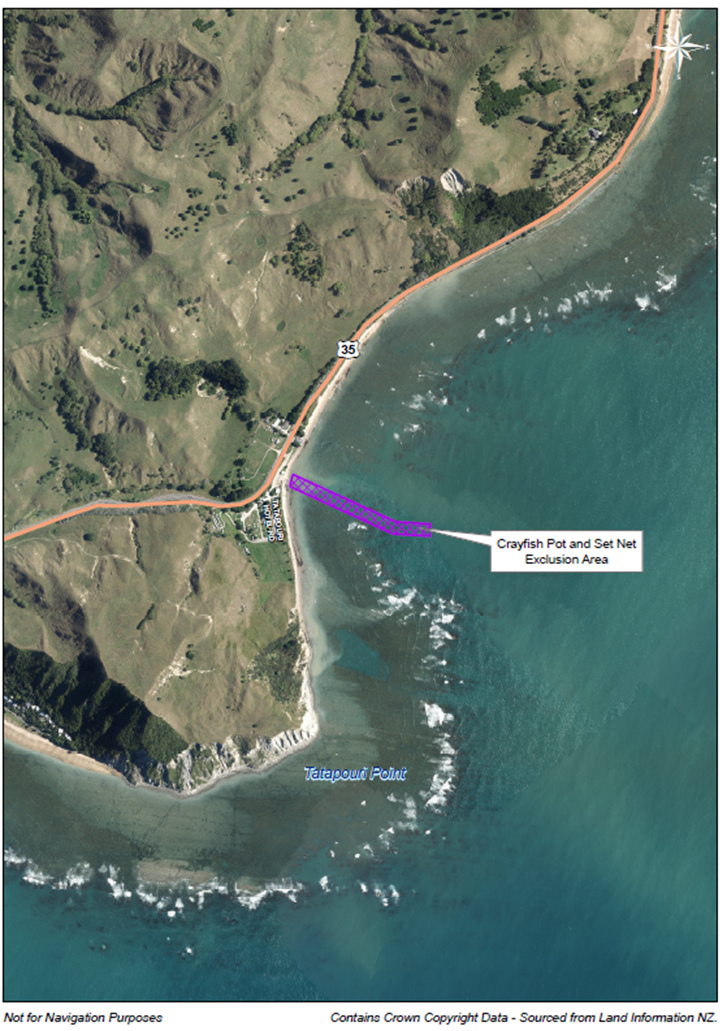The Tairāwhiti Navigation Safety Bylaw 2024 came into force 4 October 2024. This bylaw applies to all navigable waters within the Gisborne District.
The purpose of this bylaw is to ensure maritime safety and minimise the risk of fatalities, injuries, nuisance, accidents, collisions and damage on Gisborne District’s navigable waters. The harbourmaster has the power to enforce this bylaw.
An indicative map
The Harbourmaster has the power to enforce this bylaw over all internal Tairāwhiti waters and coastal waters out to the 12 nautical mile limit.
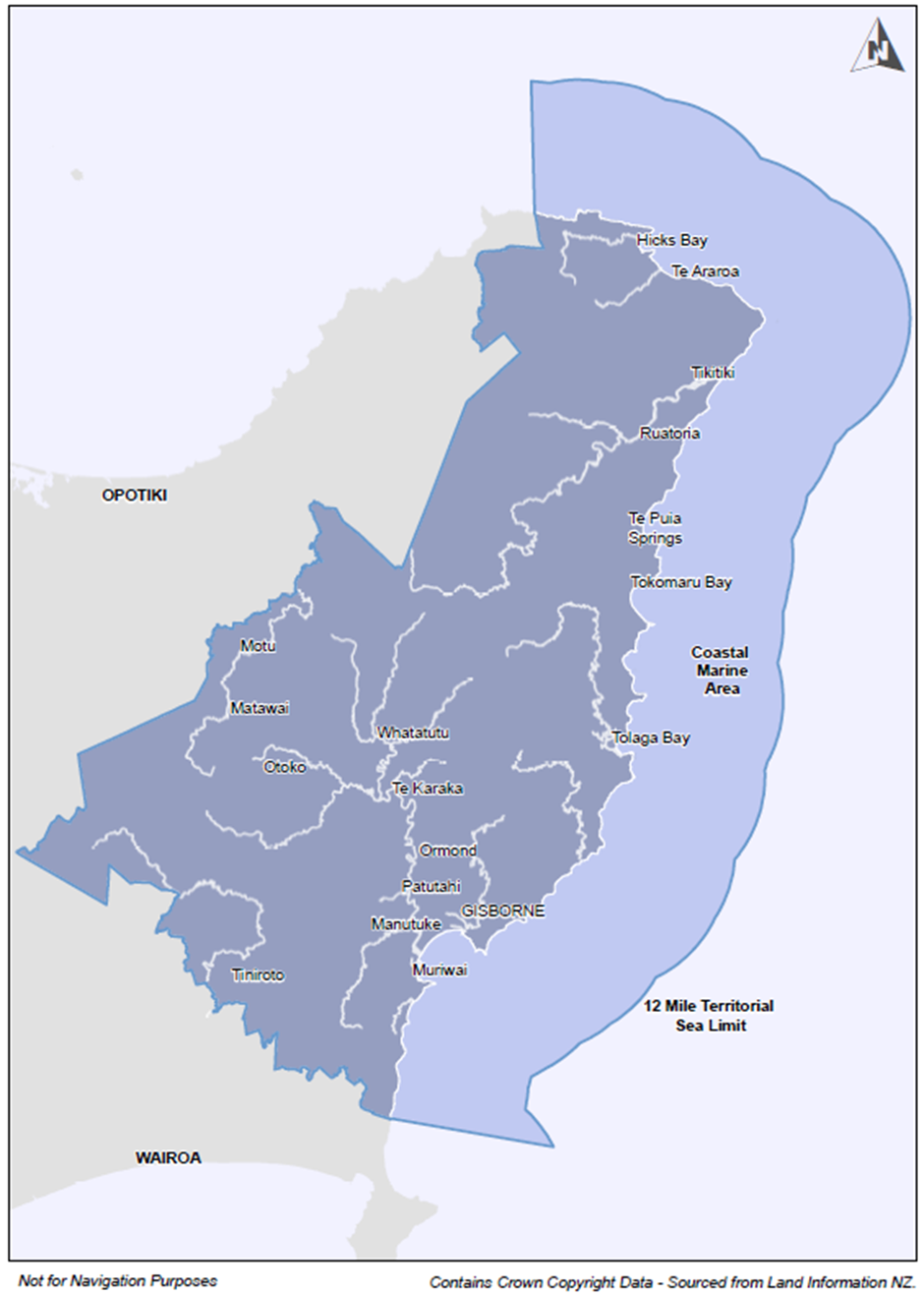
This bylaw applies to all navigable waters within the Gisborne District. The Harbourmaster has the power to enforce this bylaw.
Related information:
Other legislation and regulatory tools apply to the regulation of maritime activities, including the Maritime Transport Act 1994 and the regulations and rules under that Act.
These should be referred to in conjunction with this bylaw.
The Harbourmaster has the power to enforce this bylaw over all internal Tairāwhiti waters and coastal waters out to the 12 nautical mile limit. This area is indicated by the map above and on page 2 of this bylaw.
To apply for a licence or exemption which the Harbourmaster may grant under clauses 8(6), 18 (3), 27 (2), 30(3), 39(4) of this bylaw, email harbourmaster@gdc.govt.nz
(1) In this bylaw, unless the context otherwise requires ―
Access lane means those areas defined by words and maps in Parts 1 and 2 of Schedule 1 of this bylaw.
Act means the Maritime Transport Act 1994 and the regulations and rules under that Act.
Anchorage in relation to vessels, means a place (enclosed or otherwise) used for the anchoring of vessels to the bed of waters, whether the place is reserved for such purposes by the Council or not.
Anchor / anchoring / anchored means the securing of a vessel to the bed of waters by means of an anchor, cable or other device that is normally removed with the vessel when it leaves the anchorage.
Beacon means a light or mark which is non-floating and fixed to the seafloor or the coast (such as a pole or a lighthouse) set up as a navigation mark or a warning to vessels.
Body board also known as a boogie board, means a short foam board usually ridden in a prone or kneeling position and not designed to be ridden standing up.
Buoy means an anchored float serving as a navigation or locational mark, or to indicate a mooring, reef or other hazard.
Commercial vessel means a vessel that is not –
(a) a pleasure craft; or
(b) solely powered manually; or
(c) solely powered by sail.
Related Information:
In Maritime Rule 91, pleasure craft means a vessel that is used exclusively for the owner’s pleasure or as the owner’s residence, and is not offered or used for hire or reward; but does not include —
(a) a vessel that is provided for the transport or sport or recreation by or on behalf of any institution, hotel, motel, place of entertainment, or other establishment or business(b) a vessel that is used on any voyage for pleasure if it is normally used or intended to be normally used as fishing vessel or for the carriage of passengers or cargo for hire or reward
(c) a vessel that is operated or provided by any club, incorporated society, trust, or business.
In Maritime Rule 91, reward the payment to or for the benefit of the owner or master of a vessel, of a contribution towards the expenses of a voyage by or on behalf of persons; but does not include payment of any contributions by part owners of the vessel or by persons engaged as bona fide crew members
Council means the Gisborne District Council and includes any person authorised by the Council to act on its behalf.
Director means the person who holds the position of Director of Maritime New Zealand under section 439 of the Maritime Transport Act 1994.
Dangerous Goods has the same meaning as defined in Part 24A of the Maritime Rules.
Diver’s marker float means any float that can be deployed on or before surfacing by a SCUBA diver, and can include a safety sausage or surface marker buoy.
Enforcement Officer means a person appointed by the Council as an Enforcement Officer under section 33G of the Maritime Transport Act 1994.
Explosive has the same meaning as defined in section 2 of the Hazardous Substances and New Organisms Act 1996
Flag A means flag A of the International Code of Signals (the diver’s flag), being a burgee (swallow-tailed) flag, or rigid equivalent, coloured in white and blue with white to the mast, of not less than 600mm by 600mm.
Flag B means flag B of the International Code of Signals, being a burgee (swallow-tailed) flag, or a rigid equivalent, coloured in red, of not less than 600mm by 600mm.
Gisborne District means the area defined by the Local Government (Gisborne Region) Reorganisation Order 1989 as “The Gisborne District” and “The Gisborne Region.”
Gisborne Harbour Limits means the area of Gisborne Harbour as defined and mapped in Part 1 of Schedule 2 of this bylaw.
Gisborne Pilotage Area means the area of Gisborne Harbour as defined and mapped in Part 5 of Schedule 2 of this bylaw.
Harbourmaster means a person appointed by the Council as Harbourmaster under section 33D of the Maritime Transport Act 1994 and includes any Deputy Harbourmaster.
Hot work operations includes activities such as welding, grinding, soldering, or other work involving flames or generating sparks.
Length overall in relation to a vessel, means the distance measured at the waterline from the foremost part of the bow to the aftmost part of the stern but not including fixtures such as external engines or bowsprits.
Lifejacket means a personal floatation device as defined by Maritime Rule 91.2.
Related Information:
In Maritime Rule 91.2, a personal floatation device includes:
(a) a device that meets NZ Standard 5823:2005; and
(b) a device that meets any other standard which the Director of Maritime New Zealand is satisfied substantially complies with NZ Standard 5823:2005.
Mooring means any weight or article placed in or on the sea bed or lake bed for the purpose of securing a vessel or floating structure; and
(a) includes any wire, chain, rope, buoy or other device attached or connected to the weight; but
(b) does not include an anchor that is removed with the vessel or floating structure when it leaves an anchorage.
Mooring area means an area defined by the Council as a mooring area in the Tairāwhiti Resource Management Plan.
Navigable Waters means any waters in the Gisborne District whether coastal or inland which are able to be navigated out to the 12 nautical mile limit, and includes harbours.
Related Information:
An indicative map showing the Gisborne District navigable waters is above and on page 2 of this bylaw.
Navigate means the act or process of managing or directing the course of a vessel on, through, over or under the water.
Nuisance has the same meaning as defined by section 29 of the Health Act 1956 and includes a person, animal, thing or circumstance causing unreasonable interference with the peace, comfort or convenience of another person whether or not that person is in a
public place.
Owner includes:
(a) in relation to a vessel, the person or persons having the right to manage the vessel; and
(b) in relation to a vessel, the agent of the owner and also a charterer; and
(c) in relation to any dock, wharf quay or slipway, includes a lessee of the dock, wharf, quay or slipway.
Paddle craft means powered only by a vessel’s occupant(s) using a single or double bladed paddle as a lever without the aid of a fulcrum provided by rowlocks, thole pins, crutches or like arrangements, but does not include a raft manoeuvred solely by paddles.
Person in charge of a vessel excludes Pilot, and means:
(a) the master, skipper, or kaihāutu; and
(b) in the absence of a person in (a), the owner of the vessel that is on board or the person steering the vessel; and
(c) in the absence of a person in (a) and (b), the owner of the vessel.
Personal Water Craft (PWC) means a vessel defined as a personal water craft by section 33B of the Act, and includes a jet ski.
Pilot in relation to any vessel, means any person not being the person in charge of a vessel or a member of the crew of the vessel who has the conduct of the vessel and who is duly licensed by Maritime New Zealand.
Power driven vessel means any vessel propelled by machinery.
Proper speed means speed through the water.
Recreational craft means a vessel that is —
(a) a pleasure craft; or
(b) solely powered manually; or
(c) solely powered by sail.
Reserved area means an area of water reserved for a specific purpose as defined by words and maps in Schedule 1 of this bylaw.
Restricted visibility means any condition in which visibility is restricted by fog, mist, falling snow, heavy rainstorms, sandstorms, or other similar causes.
Sailboard means any type of board that is propelled by a detachable sail apparatus and operated by a person standing on the board. This includes windsurfers, wing sailors, kite surfers, and any hydro foiling variations of these.
Seaplane means a flying vessel or any other aircraft designed to manoeuvre on the water.
Seaworthy means being in a fit condition or readiness to safely undertake a sea voyage as determined by the Harbourmaster.
Shore when referring to distance from shore, means distance from the water’s edge.
Shore SCUBA diver means a diver using breathing apparatus that enters and exits the water from shore and not a vessel.
Structure means any building, equipment, device or other facility which is fixed to land; and includes slipways, jetties, pile moorings, swing moorings, rafts, wharves, marine farms and other objects whether or not these are above or below the waterline; but does not
include buoys, beacons, anchored floats or navigational aids.
Sunrise/Sunset has the same meaning as defined in the New Zealand Nautical Almanac (NZ204).
Support Vessel means a vessel used for coaching, marshalling, or rescue roles for training, regattas and competitions, ceremonial or other authorised recreational activity.
Surfboard means any type of board that is designed to be used for surf riding and includes hydro foiling variations.
Tanker means any vessel with a compartment or compartments that are specially constructed or adapted for bulk carriage of oil products or noxious liquid substances and:
(a) has oil products or noxious liquid substances on board; or
(b) has an empty tank that is not certified as gas free.
Underway means that a vessel is not at anchor, or made fast to the shore, or aground.
Unseaworthy means, in the opinion of the Harbourmaster, either or both of the following:
(a) not being in a fit condition or readiness to safely navigate or remain on the water;
(b) not being in a fit condition or readiness to safely undertake a voyage within its design capabilities.
Vessel means every description of ship, boat or craft used in navigation, whether or not it has any means of propulsion; and includes:
(a) a barge, lighter, or other like ship:
(b) a hovercraft or other thing deriving full or partial support in the atmosphere from the reaction of air against the surface of the water over which it operates:
(c) a submarine or other submersible:
(d) a seaplane while it is on the surface of the water.
(2) Any undefined words, phrases or expressions used in this bylaw have the same meaning as in the Act or Maritime Rule unless the context plainly requires a different meaning.
(3) The Legislation Act 2019 applies to the interpretation of this bylaw.
(4) Related information is for information purposes only, does not form part of this bylaw, and may be inserted or changed by the Council at any time without amending the bylaw.
Related information:
This bylaw refers to Maritime Rules, made under the Maritime Transport Act 1994. These
can be viewed on the Maritime New Zealand website: https://www.maritimenz.govt.nz/rules
The purpose of this bylaw is to ensure maritime safety and minimise the risk of fatalities, injuries, nuisance, accidents, collisions and damage on Gisborne District’s navigable waters.
Part 1 General matters
(1) Compliance with this bylaw does not remove the duty to comply with the requirements of the Act, and applicable rules and regulations made under the Act.
(2) The person in charge of a vessel is responsible for the safety and wellbeing of every person on board and for the safe operation of the vessel.
(3) Where any clause in this bylaw imposes an obligation or duty on both the person in charge of a vessel and the owner that is not complied with, both the person in charge of the vessel and the owner will have committed an offence, jointly and severally. If any such clause is complied with by either the person in charge of the vessel or the owner, then, for the purposes of this bylaw, compliance by one is deemed to be compliance by the other.
(4) Where any clause in this bylaw imposes an obligation or duty on any vessel without reference to its owner or person in charge, it shall be the responsibility of the person in charge of the vessel to ensure the vessel complies with that duty or obligation.
(1) No person shall operate any vessel in breach of Part 22 of the Maritime Rules (Collision Prevention), or any other relevant rule made under the Act.
(2) The owner or person in charge of a vessel that has been involved in any collision, accident or incident on navigable waters shall report the details of the occurrence to the Director and the Harbourmaster, that results in or could result in:
(a) damage to a vessel which affects the operational capability of the vessel; or
(b) any damage to a navigation aid or any structure; or
(c) a vessel, or property, being sunk or grounded or becoming stranded in any navigable waters in the Region; or
(d) by reason of accident, fire, defect or otherwise the vessel being in such a condition as to affect its safe navigation or to give rise to danger to any person, other vessels or property; or in any manner gives rise to an obstruction; or
(e) any person being injured.
(3) A notification under clause 7(2) must be provided to the Director as soon as practicable and must comply with any accident reporting requirements of the Act.
(4) A notification under clause 7(2) must be provided to the Harbourmaster:
(a) verbally as soon as possible; and
(b) in writing as soon as practicable or at least within 48 hours.
(5) A notification under clause 7(2) made to the Harbourmaster must include the following information:
(a) the names and addresses of persons in charge of the vessel; and
(b) a full description of any injury to persons; and
(c) a full description of any damage to vessels, navigation aids or structures; and
(d) the time and date of the occurrence; and
(e) an outline of events relating to the occurrence
(6) If an incident described in clause 7(2) involves damage to a vessel that affects, or is likely to affect, its seaworthiness, the person in charge of the vessel may not move the vessel except:
(a) to allow the vessel to moor or anchor in safety, preventing sinking or other emergency circumstances such as seeking medical attention; or
(b) to prevent the vessel from creating a hazard to navigation; or
(c) in accordance with the directions of the Harbourmaster or an Enforcement Officer.
(7) The Harbourmaster may require further information from the person in charge of a vessel or owner of a vessel following a notification under clause 7(2) which must be provided within 48 hours (or such longer timeframe as the Harbourmaster may permit).
Related information:
Notifications to the Harbourmaster can be sent to harbourmaster@gdc.govt.nz.
To report an accident or incident to Maritime New Zealand, you can use their online form at https://www.maritimenz.govt.nz/forms/incident
(1) The person in charge of a recreational craft may only use it or allow it to be used if it carries, lifejackets of an appropriate size for each person on board in a readily accessible location at the time of use.
(2) The person in charge of any recreational craft that is 6 metres or less in length overall must ensure that every person on board is wearing a properly secured lifejacket of an appropriate size for that person while the craft is underway.
(3) The person in charge of any recreational craft must ensure that every person on board is wearing a properly secured lifejacket of an appropriate size for that person, whenever there is any risk to the safety of the people on board, including circumstances such as tides, river flows, visibility, rough seas, adverse weather, emergencies or other situations which may cause danger or a risk to the safety of any person on board the craft.
(4) Clauses 8(1), (2) and (3) do not apply to:
(a) any surfboard or similar unpowered craft being used to ride travelling waves; and
(b) any sailboarder if a wetsuit is worn at all times; and
(c) a diver on a vessel of six metres or less in length overall that is used for recreational diving within five nautical miles of shore, if a full body dive suit is worn at all times; and
(d) a person training for or participating in a sporting event, if the training or the event is supervised in accordance with Maritime Rule 91.4(2)(d); and
(e) any surfboard or similar unpowered craft, not covered by clause 8(4)(a), provided:
- (i) a leash is used as appropriate for the conditions, and
(ii) it is being used within 200 metres of the shore.
(5) In respect of any sporting event, training activity, ceremonial event or other organised recreational activity, clauses 8(1) and 8(2) shall not apply if a support vessel that is capable of providing adequate assistance in the event of an emergency remains in the immediate vicinity of the recreational craft and the support vessel carries lifejackets of an appropriate size for each person on board the support vessel and the recreational craft.
(6) In respect of any sporting event, training activity or other organised recreational activity, the organising body may, where it is not practical to meet the requirements of clause 8(5), apply for a written exemption to clauses 8(1) and 8(2) from the Harbourmaster, who may grant an exemption for a specified time period, provided that the Harbourmaster is satisfied that adequate safety precautions are made for rescuing any persons participating in the event or activity.
7) The person in charge of a vessel must not allow the vessel to tow any person, unless the person being towed wears a properly secured lifejacket of an appropriate size for that person.
(8) The person allowing themselves to be towed by any vessel must wear a properly secured and appropriately sized lifejacket.
(9) Clauses 8(7) and 8(8) do not apply to a person:
(a) training for any trick water skiing element of a sporting event administered by a national sporting organisation approved under Maritime Rule 91.4(3); or
(b) participating in a sporting event that is administered by a national sporting organisation approved under Maritime Rule 91.4(3).
(1) Every person in charge of a vessel must carry on board their vessel at least two means of communication in good working condition that:
(a) provides the ability to communicate with land based and/or seaborne parties from any point within the area the vessel will be operated; and
(b) in the case of vessels under 6 metres in length overall, is able to be operated following submersion in sea water; and
(c) is adequate to provide communications for the duration of the voyage.
(2) Despite clause 9(1), a person in charge of an unpowered vessel being operated within the Gisborne Harbour Limits, or within 1000 metres of the coast, must ensure that at least one waterproof means of communication in good working condition is carried on board the vessel.
(3) Clauses 9(1) and 9(2) do not apply to:
(a) a person participating in a sporting event or training activity if there is a support vessel present that complies with clause 9(1); and
(b) any surfboard or similar unpowered craft being operated within the Gisborne Harbour Limits, or within 1000 metres of the coast.
Part 2: Activities and specified areas
(1) Every person diving from a vessel must ensure that Flag A is displayed in such a manner that it can be clearly identified by the watchkeeper of another vessel at a distance in excess of 200 metres.
(2) The person in charge of a vessel from which dive operations are in progress must ensure that Flag A is displayed in such a manner that it can be clearly identified by the watchkeeper of another vessel at a distance in excess of 200 metres.
(3) Any free-diver from shore intending to dive more than 200 metres from shore must either tow a bright-coloured safety float or use a raft displaying Flag A.
(4) Any shore SCUBA diver that intends to surface or is likely to surface more than 200 metres from shore must have a diver’s marker float that marks their position when surfacing.
(5) Any person undergoing dive operations must submit a completed Dive Notification form to the Harbourmaster at least 2 hours prior to the intended start time of operations.
(6) Any person undergoing dive operations must comply with all conditions imposed by the Harbourmaster after receiving their Dive Notification Form.
Related information:
A Dive Notification form template can be found on the Council’s website at https://www.gdc.govt.nz/environment/coast-and-harbour.
Completed forms can be sent to the Harbourmaster at harbourmaster@gdc.govt.nz
(1) Any person in navigable waters must not dive, jump, or swim within 50 metres of:
(a) any structure in the commercial port area as defined in the Tairāwhiti Resource Management Plan; or
(b) any wharf, boat ramp or designated boat launching area while a vessel is within 50 metres of the area.
(2) Clause 11(1) does not apply to any person operating in accordance with a Dive Notification form submitted to and approved by the Harbourmaster.
(3) Notwithstanding clause 11 (2), no person may undergo dive operations in the areas identified in clause 11 (1) if, upon receiving their Dive Notification form, the Harbourmaster directs them not to (either temporarily until a certain time or at all).
Any person swimming in navigable waters more than 200 metres from shore must tow a bright-coloured safety float or swim buoy or must wear a brightly coloured swim cap, unless accompanied by a support vessel.
(1) The person in charge of a vessel that is towing another person or object must:
(a) have at least one additional person on board who is 10 years of age or older who is responsible for immediately notifying the person in charge of every mishap that occurs to the person and/or object being towed; and
(b) not tow any person or object between sunset and sunrise or in restricted visibility.
(2) Any person allowing themselves to be towed by a vessel must ensure the provisions of clause 13(1) are met.
(1) Access lanes are defined in Parts 1 and 2 of Schedule 1 of this Bylaw.
(2) The person in charge of a vessel must manoeuvre it by the most direct route through the access lane and on the side of the access lane that lies to the starboard or right-hand side of the vessel.
(3) Any person allowing themself to be towed through an access lane must ensure they, and any other object being towed alongside them, travel by the most direct route and on the side of the access lane that lies to the starboard or right-hand side of the vessel.
(4) The person in charge of a vessel operating within an access lane must ensure that they do not obstruct or cause any damage to any other vessel or to any other person in the access lane.
(5) If any person is using an access lane for the purpose for which it is declared, no other person may enter, remain in, use or obstruct the lane for any other purpose.
Related information:
Access lanes are clearly marked on shore with signage communicating the purpose of the access lane, as well as by pairs of posts in transit. The posts will be orange with black horizontal bands. The access lane may also be marked in the water by orange buoys with vertical black stripes.
(1) Reserved areas are defined in Schedule 1 of this Bylaw.
(2) If any person is using a reserved area for the purpose for which it is reserved, no other person may enter, remain in or use the area for any other purpose.
(3) No person may obstruct another person while the other person is using a reserved area for the purpose for which it is reserved.
Related information:
Any permanent reserved areas will be clearly marked on shore with signage communicating the purpose of the reserved areas. Any permanent reserved area will also be marked either:
(a) on shore, by pairs of white posts in transit, with black horizontal bands; or
(b) at sea, by black buoys with white vertical stripes.
(1) Surf Life Saving New Zealand or a person authorised by Surf Life Saving New Zealand, may, from time to time, subject to clause 17, set aside areas of beaches as flagged areas for the purposes of swimming and body boarding only.
(2) Flagged swimming areas set aside under clause 16(1) shall consist of two red/yellow flags forming the area boundary. These flags shall meet NZ Standard NZS8690:2003 – 5.1 Design of flags and 5.2 Use of flags.
(3) Any person within navigable waters and 200 metres of the shore of a flagged area of a beach must only carry out activities for which the area has been flagged, with the exception of Surf Lifesaving or other rescue services operating a vessel in this area in case
of an emergency.
(1) Any person intending to conduct a race, speed trial, competition, hire operation, or other organised water activity in any area to which this bylaw applies must apply to the Harbourmaster to:
(a) temporarily suspend the relevant speed clause(s) and any other relevant clause of this bylaw in that area during the conduct of the activity; and/or
(b) temporarily reserve the area for the purpose of that activity; and/or
(c) temporarily suspend the designation of permanent access lanes or reserved areas; and/or
(d) temporarily install course markers of similar such structures in the water.
(2) Where the Harbourmaster is satisfied, on considering an application under this bylaw, that the application may be granted without endangering the public, the Harbourmaster may grant the application accordingly, for a period not exceeding 10 days, and on such
conditions (if any) as they may specify.
(3) No grant of an application under this bylaw shall have effect unless, not less than seven days or more than 14 days before the commencement of the activity, the applicant publicly notifies the purpose, period and location of the activity and details of any suspension or reserved area.
Related information:
Temporary event authorisation application form
Completed forms can be sent to the Harbourmaster at harbourmaster@gdc.govt.nz
Commercial operations within any area to which this bylaw applies may also be subject to a licencing regime under the Maritime Rules (including but not limited to a Maritime Transport Operator Certificate), or other regulatory instruments such as the Amusement Devices Regulations 1978, or the Health and Safety at Work (Adventure Activities) Regulations 2016.
Part 3: Operating requirements
(1) No person may allow a person under the age of 15 years to be in charge of, or propel or navigate, a power-driven vessel that is capable of a proper speed exceeding 10 knots unless under the direct supervision of a person over the age of 15 years who is in immediate reach of the controls.
(2) The owner of a power driven vessel that is capable of a proper speed exceeding 10 knots must not allow any person who is under the age of 15 years to be in charge of, or propel or navigate that vessel in contravention of clause 19(1).
(3) The Harbourmaster, for the purposes of training, competitions or other sporting events:
(a) may give exemptions to clauses 18(1) and 18(2); and
(b) when considering whether or not to grant such an exemption, must have regard to the competence of the person, the level of supervision, and awareness of other relevant navigation safety matters.
(4) Clauses 18(1) and 18(2) do not apply to any person who has a written exemption from:
(a) the Harbourmaster under clause 18(3); or
(b) the Director under the Act.
(1) A person in charge of a vessel (including a vessel towing a person or object) must not propel or navigate the vessel at a proper speed exceeding 5 knots:
(a) within 50 metres of any other vessel or person in the water; or
(b) either within 200 metres of the shore or of any structure, which includes on the inshore side of any buoy(s) demarcating 200 metres from the shore or structure; or
(c) within 200 metres of any vessel or floating structure that is flying Flag A; or
(d) when knowingly or deliberately approaching within 200 metres of a marine mammal.
(2) A person in charge of a power driven vessel must not propel or navigate the vessel at a proper speed exceeding 5 knots while any person has any portion of their body extending over the fore part, bow or side of that vessel.
(3) No person may cause or allow themself to be towed by a vessel or any other means (whether or not on a water ski, aquaplane or other towed object) at a proper speed exceeding 5 knots in any circumstances specified in clauses 19(1)(a), (b), or (c).
(4) A person in charge of a vessel must not permit the vessel to continue onwards, after any person being towed by that vessel has dropped (whether accidentally or otherwise) any water ski which may cause danger to any other person or vessel, without taking appropriate action to recover that water ski or take measures to ensure that the water ski is visible to other water users.
(5) A person in charge of a vessel must not navigate that vessel in a manner that causes a nuisance to others.
(6) Clause 19(1)(a) does not apply to:
(a) a vessel over 500 gross tonnage, if the vessel cannot be safely navigated in compliance with clause19(1)(a); or
(b) a vessel powered by sail in relation to any other vessel powered by sail, while the vessels are participating in a yacht race or training administered by:
- (i) a club affiliated to Yachting New Zealand; or
(ii) a non-profit organisation involved in sail training or racing; or
(c) a craft training for or participating in competitive rowing or paddling; or
(d) a tug, pilot vessel, harbourmaster vessel, emergency response craft or police vessel, if the vessel’s duties cannot be performed in compliance with Clause 19(1)(a).
(7) Clause 19(1)(b) does not apply to:
(a) a vessel operating in an access lane or a reserved area for the purpose for which the access lane or reserved area was declared; or
(b) a vessel over 500 gross tonnage, if the vessel cannot be safely navigated in compliance with clause 19(1)(b); or
(c) a vessel powered by sail in relation to any other vessel powered by sail, while the vessels are participating in a yacht race or training administered by:
- (i) a club affiliated to Yachting New Zealand; or
(ii) a non-profit organisation involved in sail training or racing; or
(d) a sailboard; or
(e) a vessel training for or participating in competitive rowing or paddling; or
(f) a tug, pilot vessel, harbourmaster vessel, emergency response craft or police vessel when the vessel’s duties cannot be performed in compliance with clause 19(1)b).
(8) Clauses 19(1)(b) and 19(2) shall not apply to a vessel operated by a Surf Lifesaving Club affiliated to Surf Lifesaving New Zealand, that is being operated in accordance with the appropriate operating procedures that have been approved by the Harbourmaster.
Subject to clause 19, every person who propels or navigates a recreational craft must ensure that its wake or the wake from any person or object being towed:
(a) does not prevent other people from safely using the waterway;
(b) does not cause unnecessary danger or risk of damage to other vessels or structures, navigational aids; and
(c) does not cause risk of harm to other persons or property.
(1) No person in charge of a vessel may operate the propulsion system of the vessel while at any wharf, boat ramp, or designated boat launching area, in such a way that it may damage any structure or property, scour the bed of the waters, or injure any person.
(2) Clause 21(1) does not preclude the use of the propulsion system for the safe berthing or unberthing of any vessel at a wharf.
(1) The person in charge of a vessel anchored or moored in navigable waters must keep the vessel in a seaworthy condition at all times. If the Harbourmaster notifies a personin charge of a vessel that their vessel is in an unseaworthy condition, they may not anchor or moor the vessel without written approval from the Harbourmaster.
(2) The written approval from the Harbourmaster may be subject to such conditions as the Harbourmaster may determine appropriate to ensure navigation safety.
(3) If the Harbourmaster has notified a person that any vessel is unseaworthy and the Harbourmaster has determined that it may become a navigation hazard, then:
(a) the Harbourmaster may give a written direction to the person in charge of a vessel to move the vessel to an alternative location or to remove it from the waters within a reasonable time as specified in the direction; and
(b) the owner and person in charge of a vessel are jointly and severally responsible for ensuring the direction is complied with.
(4) If any person fails to move the vessel in accordance with a direction given under clause 21(2), the Harbourmaster may move that vessel to a position where it is no longer a hazard to navigation, or remove it from the water. The costs incurred may be recovered from the owner or person in charge of the vessel in any court of competent jurisdiction as a debt due to the Council.
(5) If the Harbourmaster has notified a person in charge of a vessel that their vessel is in an unseaworthy condition, they may not operate the vessel within navigable waters except to comply with the directions of the Harbourmaster or an Enforcement Officer to move the vessel to an alternative location or:
(a) to allow the vessel to moor or anchor in safety, preventing sinking or other emergency circumstances such as seeking medical attention; or
(b) to prevent the vessel from creating a hazard to navigation.
Related information:
The Harbourmaster has the power to sell and dispose of a vessel and recover any costs if the owner fails to comply with this bylaw and pay any costs associated with the seizure, impoundment, transport and storage under Sections 164, 167 and 168 of the Local Government Act 2002.
(1) No person navigating a vessel may impede a seaplane in the process of landing or taking off.
(2) No person may navigate a vessel with a mast or superstructure in excess of 15 metres above sea level within the defined Aircraft Approach Area as described and shown in Part 6 of Schedule 2 of this bylaw.
(1) No person may anchor a vessel so as to:
(a) obstruct the passage of other vessels or obstruct the approach to any wharf, pier or jetty; or
(b) create a hazard to other vessels at anchor, or
(c) leave the vessel unattended for more than 24 hours without prior permission of the Harbourmaster.
(2) Except in an emergency involving danger to life or property, no person may cut, break, destroy or unlawfully detach:
(a) the mooring of any vessel; or
(b) the fastening securing any vessel lying in, at or near a wharf, dock or at or near any wharf or landing place.
(3) When a vessel is moored in, at or alongside a wharf or dock or other landing place, the person in charge of a vessel must ensure that adequate and safe means of access to the vessel is provided, properly installed, secured and adjusted to suit all tidal conditions.
(4) The person in charge of a vessel berthed at a wharf must ensure that it is securely fastened at all times and, if required by the Harbourmaster, maintain a person on board to keep watch.
(5) No person may moor to a public wharf for more than eight hours without permission of the wharf owner. This does not preclude the wharf owner from restricting berthage to a shorter time.
(6) No person may allow a vessel to be anchored in the same location or within one nautical mile of the previous overnight anchorage for longer than 14 consecutive days without the prior permission of the Harbourmaster.
(7) Any person intending to live on board a vessel at anchor or on a mooring for more than five consecutive nights shall inform the Harbourmaster of where the vessel will be anchored or moored and the expected duration of their living on board.
(8) No person may allow a vessel to use a mooring without the mooring owner’s permission.
Related information:
In the event of adverse weather, the Harbourmaster will issue timely direction to a person in charge of a vessel at anchor to depart the anchorage prior to adverse weather that may cause vessels to drag their anchors onto a lee shore. Directions will be issued in accordance with Standard Operating Procedure 001/2022.
No person may anchor or moor any vessel within any prohibited anchorage as defined in Part 4 of Schedule 2 of this bylaw.
(1) No person in charge of a large vessel (over 500 gross registered tonnage) may allow it to be anchored or moored at any place within the Gisborne Harbour Limits other than at the three permanent anchorage positions as defined in Part 3(a) of Schedule 2 of this Bylaw.
(2) No person in charge of a cruise ship may allow it to be anchored or moored at any place within the Gisborne Harbour Limits other than at the cruise ship anchorage positions as defined in Part 3(b) of Schedule 2 of this Bylaw.
(3) Only one vessel may be anchored at any anchorage position defined in Part 3 of Schedule 2 of this bylaw at any one time.
(1) No person may obstruct the passage of any other vessel, or restrict the navigation of any waterway, or the access by water to any wharf, pier, jetty, landing place, boat ramp, designated launching area, slipway or mooring.
(2) No person may navigate a vessel under their control in the swinging basin, or in the entrance channel, when a vessel exceeding 500 gross tonnes is in the channel between Tokomaru Rock Light Buoy and the entrance to the swinging basin or is in the swinging basin, as shown in Part 2 of Schedule 2 of this bylaw. The Harbourmaster may, at their discretion, grant an exemption from the requirements of this clause on such terms and conditions as they deem appropriate.
(3) No person may cause or allow any thing to be placed, left behind, dropped, or discharged over or near any navigable waters that may:
(a) restrict or cause a danger to the navigation of any other vessel; or
(b) cause or have the potential to cause injury or death to any person; or
(c) cause or have the potential to cause damage to any vessel or any other property.
(4) No person may place any obstruction, including any fishing apparatus, in any waters that is likely to:
(a) restrict navigation; or
(b) cause or have the potential to cause, loss of life or injury to any person; or
(c) cause or have the potential to cause, damage to any vessel or any property.
(5) No person may place any obstruction, including any fishing apparatus within the Crayfish Pot and Set-Net Exclusion areas described in Part 7 of Schedule 2of this bylaw.
(6) Any person who loads, discharges or drops cargo or any other material into navigable waters, or in contravention of clauses 27(4) and 27(5) of this bylaw, shall be liable for the costs of removal.
(1) No person may tie a vessel to any buoy, beacon or other device or structure erected as a navigation aid, warning marker or sign without the prior written permission of the Harbourmaster.
(2) No person may damage, remove, deface or otherwise interfere with any buoy, beacon or other device or structure erected as a navigation aid, warning marker or sign.
(3) No person may erect, maintain or display any beacon, buoy or other device, which may be used as, or mistaken for, a recognised navigation aid, without the written permission of the Harbourmaster and the Director.
(1) No person shall use any flashing lights, sirens or other sound or light signals not prescribed in a Maritime Rule for that vessel, without the permission of the Harbourmaster.
(2) For the avoidance of doubt, the application of clause 29(1) includes the use of blue flashing lights and/or sirens which is restricted to Police, Customs, Harbourmaster or other enforcement vessels authorised by the Harbourmaster.
(3) A person in charge of a vessel authorised to use purple flashing lights by the Harbourmaster shall only display them when:
(a) The use is required to assist the location of a vessel or person in need of assistance.
(b) The use is required to assist the identification of the vessel to an aircraft involved in an incident.
(c) Is otherwise directed to do so by the Police or Harbourmaster.
(4) No person may blow or sound the whistle, siren or horn of a vessel, within the Gisborne harbour limits, except as a navigation safety signal or with permission of the Harbourmaster, or for testing of equipment before the vessel leaves any wharf.
(1) No person may place a mooring in any navigable waters, whether in a mooring area or not, unless:
(a) the mooring has valid resource consent; or
(b) a mooring licence has been granted by the Harbourmaster per clause 30(3) of this bylaw.
(2) The Harbourmaster may remove or authorise the removal of any unauthorised mooring and all costs of so doing are a debt by the owner of the mooring to the Council.
(3) The Harbourmaster may, at their discretion, grant a mooring licence, and impose such terms and conditions on the licence as they deem appropriate.
(4) Every mooring licence issued by the Harbourmaster under clause 30(3) shall apply only to the vessel and owner(s) named in the licence.
(5) The Harbourmaster shall not grant any licence for a mooring under clause 30(3) unless satisfied that:
(a) there is adequate space in the mooring area for the proposed mooring; and
(b) the mooring is of adequate specifications to accommodate the proposed vessel to be moored there.
(6) No owner of a licensed mooring may leave a mooring vacant or unattended for a period of longer than six months without the written permission of the Harbourmaster.
(7) Where the owner of a mooring has left it vacant or unattended for a period of longer than six months without the written permission of the Harbourmaster, the Harbourmaster may cancel the licence and direct that the mooring be removed.
(8) No owner of a licensed mooring may, except with the written permission of the Harbourmaster:
(a) part with the possession of the mooring; or
(b) assign the mooring to any other person; or
(c) suffer any such other person to have the use of the mooring; or
(d) use the mooring for a vessel other than the vessel named in the licence.
(1) No person may place a marker buoy in any navigable waters unless that buoy is clearly and permanently marked, or fitted with a permanent tag, showing at least one of the following—
(a) the owner’s initials and surname, and contact telephone number or address; or
(b) in the case of a mooring, the mooring licence number.
(2) No person may place a marker buoy in any navigable waters unless that buoy is sufficiently buoyant to remain at least 50 per cent afloat or otherwise clearly visible.
(3) No person shall place a buoy in any navigable waters so that it becomes a hazard to navigation.
(1) A person conducting bunkering operations to or from a vessel must:
(a) Notify the Harbourmaster, in accordance with the Fuel Transfer notification form, at least two hours before the commencement of the operations; and
(b) Monitor the operation in accordance with International Convention for the Prevention of Pollution from Ships (MARPOL) regulations and recommendations and otherwise in accordance with the Marine Protection Rules.
(2) No person may conduct a transfer of oil to or from any vessel or otherwise operate an oil transfer site without being in physical possession of an approved marine oil spill contingency plan that complies with the requirements of Marine Protection Rule 130B.
(3) Any automatic pumping arrangement within the Gisborne Harbour Limits shall be monitored at all times by the person conducing bunkering operations under clause 32(1), and that person shall not leave the pumping unattended.
Related information:
A Fuel Transfer Notification form template can be found on our website
Completed forms can be sent to the Harbourmaster at harbourmaster@gdc.govt.nz
Part 4: Commercial operations
(1) While in harbour, the person in charge of an oil tanker must operate in accordance with the International Safety Guide for Oil Tankers and Terminals (ISGOTT).
(2) The person in charge of a tanker must:
(a) berth or moor the tanker only at such berth or place as permitted in writing by the Harbourmaster; and
(b) keep the tanks containing Class 3 packing groups I and II oil cargo securely closed, except when opened for loading or discharging; and
(c) ensure that sufficient motive power and minimum safe crewing is available at all times to enable the vessel to be moved from the berth in case of fire or other emergency; and
(d) submit to the Harbourmaster a plan showing the layout of the vessel’s tanks and contents, giving the products and approximate quantities that will be on board when arriving at Harbour, at least 12 hours prior to arrival.
(1) The person in charge of a commercial vessel over 500 gross tonnage that wishes to conduct safety drills or exercises, including, but not limited to, lowering of lifeboats, must notify the Harbourmaster, in accordance with the Lifeboat Drill Notification form no less
than two hours before commencing the drill or exercise, and notify the Gisborne Port.
(2) The person in charge of any commercial vessel over 500 gross tonnage that wishes to immobilise and/or test engine must notify the Harbourmaster, no less than 24 hours before immobilising the vessel’s main engines, and notify the Gisborne Port.
(3) Activities notified under clauses 34(1) and 34(2) must only occur while the commercial vessel is at anchor, and not when alongside.
(4) The person in charge of a large vessel with inoperative or faulty navigational or manoeuvring equipment must obtain the written approval of the Harbourmaster before the vessel navigates within a pilotage area.
Related information:
A Lifeboat Drill Notification form template can be found on our website
Completed forms can be sent to the Harbourmaster at harbourmaster@gdc.govt.nz
(1) The person in charge of a vessel that has on board, or who intends to load or discharge, explosives must ensure that:
(a) no person loads or unloads explosives inside of the Gisborne Harbour Limits except with the written permission of the Harbourmaster; and
(b) no person loads or discharges class 1 explosives in navigable waters except with the written permission of the Harbourmaster; and
(c) the Harbourmaster is provided with a Dangerous Goods declaration for the explosives.
(2) A Dangerous Goods declaration provided under clause 35(1)c) must:
(a) be provided at least 48 hours prior to loading or discharging; and
(b) include Net Explosive Quantity and gross weight; and
(c) for weekend loading or discharging, be provided no later than 12 noon on the previous business day.
(3) Nothing in clause 35(1) applies to any vessel which:
(a) is carrying not more than 27 kilograms of explosives; or
(b) is carrying or is intending to load:
- (i) Fireworks in dangerous goods classifications 1.3G, 1.4G and 1.4S that are controlled under the Hazardous Substances (Fireworks) Regulations 2001 in amounts less than 500kg gross weight; or
(ii) Emergency flares and signalling devices in dangerous goods classifications 1.3G, 1.4G and 1.4S in amounts less than 100kg gross weight; or
(iii) All other 1.4S consignments in amounts less than 2,000kg gross weight.
(1) The person in charge of a vessel carrying Class 1 explosives must not allow that vessel to be berthed within 30 metres of another vessel without prior written approval of the Harbourmaster.
(2) The person in charge of a vessel carrying Class 1 explosives in excess of the quantities that require a test certificate shall berth only at a berth which complies with the Designated Transfer Zone provision of a Dangerous Goods Handling Plan. Such a plan will illustrate the limits of the Designated Transfer Zones on a case by case basis.
While in the Gisborne Harbour, the person in charge of a vessel that has on board, or who intends to load or discharge dangerous goods must:
(a) display Flag B on a prominent place of the vessel where it can best be seen from all directions between sunrise and sunset; and
(b) display an all-round red light at the masthead or where it can best be seen from all directions between sunset and sunrise.
(1) Where possible, the person in charge of a vessel underway must not allow that vessel to approach within 200 metres of a vessel showing Flag B or a red all -round light while it is at a berth, anchored, or underway.
(2) Where it is not possible for a vessel underway to be more than 200 metres away from a vessel showing Flag B or a red all-round light while it is at a berth, anchored, or underway, the person in charge of that vessel must maintain as much clearance as possible.
(3) Clause 38(1) and (2) shall not apply to a vessel acting in accordance with clause 36(1).
(1) The person in charge of a vessel on which hot works operations are to be carried out or a person who intends to conduct hot works operations on a vessel must notify the Harbourmaster, in accordance with the Hot Work Notification form no less than two hours before commencing the work.
(2) Any person carrying out the hot work or the person in chargeof a vessel or vessel’s engineer, if available, of the vessel must ensure that before any welding operations are commenced, precautions are taken for the detection, prevention and extinguishing of fire on board the vessel or elsewhere during the welding operations, and that the requirements of the Hot
Work Notification are met. Provision must be made for the continuance of the precautions until the operations are completed.
(3) The person in charge of a vessel must ensure that any hot works operations on the vessel are undertaken in accordance with the conditions of the Hot Work Notification for the work to be undertaken.
(4) The Harbourmaster may grant a licence which allows the person in charge of a vessel lying at any ship-repairing establishment to carry out hot works operations without complying with the requirements in clause 39(1).
(5) In any case where the Harbourmaster is not satisfied adequate precautions have been taken, the Harbourmaster may stop any hot work operations commencing, or continuing, until satisfied that adequate precautions have been taken.
Related information:
A Hot Work Notification form template can be found on our website
Completed forms can be sent to the Harbourmaster at harbourmaster@gdc.govt.nz
To apply for a licence under clause 39 (4), email the harbourmaster@gdc.govt.nz
(1) Any person that intends to load logs shall ensure that a plan has been submitted to the Harbourmaster that relates to the loading and recovery of lost logs. The loading needs to be monitored to immediately identify any logs that have been lost in the Gisborne Harbour Limits and track them until they can be removed.
(2) The person referred to in clause 40(1) must inform the Harbourmaster of any logs lost into the Gisborne Harbour Limits as soon as they are observed missing and again once they have been recovered.
(1) The person in charge of a vessel 500 gross tonnes or more navigating in the Gisborne Pilotage Area must ensure that:
(a) automatic-steering “pilot” devices are not used, unless a helmsman is standing by in the immediate vicinity of the helm or wheel; otherwise the vessel is to be in the hand-steering mode; and
(b) main engines are immediately available for reducing speed, stopping or going astern at all times without delay; and
(c) anchors are immediately available for use in an emergency, and capable of being used without power; and
(d) all information from aids to navigation and charts are fully monitored; and
(e) while within Gisborne Pilotage Area, all aids to navigation on board vessels, including but not limited to radar and depth recording devices, are to be in continuous operation and fully utilised; and
(f) the number of persons on the bridge of the vessel shall be sufficient to enable compliance with clause 41(1)(a).
Part 5: Administrative matters
(1) The owner and person in charge of a personal water craft (PWC) being used on navigable waters must display a distinctive individual identification number, which must be either the registration number of the PWC’s trailer, or a PWC identification number.
(2) If the PWC subject to clause 42(1) does not use a trailer registration number, the owner of the PWC must obtain a PWC identification number from the Council (or another regional council that undertakes an equivalent process for PWC) before the PWC is used on navigable waters.
(3) The owner and person in charge of the PWC subject to clause 42(1) must ensure the PWC identification number or trailer registration number is clearly displayed above the water line on both sides of the PWC at all times. Each number used shall be a minimum height of 90 millimetres, in a contrasting colour and the numbers must be legible by day from 50 metres away.
(4) The owner and person in charge of the PWC subject to clause 42(1) must ensure the PWC identification number is displayed prominently on the PWC’s trailer.
(5) The owner and person in charge of the PWC subject to clause 42(1) must notify Council of the identification number of the PWC before it is used on navigable waters.
(6) The owner of a PWC must notify the Harbourmaster within 30 days of the craft being sold or disposed of.
Related information:
A Jet ski identification notification form can be found on our website
(1) The person in charge of a vessel not covered by clause 42 shall ensure the vessel is clearly marked with a minimum of two letters or numbers which must not be a vessel’s brand, make or model, and must not have the potential to be mistaken for a vessel operated by
the Harbourmaster, coastguard, police, customs, fisheries officers, or other enforcement agency. The marking shall be clearly displayed when on navigable waters in a position above the water line on both sides of the vessel at all times.
(2) Each letter or number required by clause 43(1) shall be a minimum height of 90 millimetres, in a contrasting colour and the letters or numbers must be legible by day at a distance no less than 50 metres.
(3) If the vessel is normally carried to the water on a trailer, the vessel name or identifying letters and numbers required by clause 43(1) must also be prominently displayed on that trailer.
(4) Clause 43(1) does not apply to:
(a) non power-driven vessels; or
(b) power-driven vessels of 4 metres or less in length overall.
(5) The identification of any vessel exempted under clause 43(4)(a) or (b) must include the name and contact details of the owner displayed somewhere on the vessel.
(6) A commercial ship to which clause 43(1) applies shall be deemed to have met the requirements of clause 43(1) if it displays a Maritime New Zealand or Maritime Safety Authority number.
(1) A person commits an offence against this bylaw and is liable to a penalty under the Maritime Transport Act 1994 or Local Government Act 2002 if:
(a) they fail to comply with (breach) this bylaw; or
(b) they fail to comply with an instruction given to them by the Harbourmaster.
(2) Despite clause 44(1), a person does not commit an offence if they prove that the failure to comply was due to compliance with the directions of the Harbourmaster.
(3) The Harbourmaster may under section 163 of the Local Government Act 2002:
(a) remove or alter a work or thing that has been constructed in breach of this bylaw; and
(b) recover any costs of removal or alteration from the person who committed the breach.
(4) The Harbourmaster may use their powers under the Maritime Transport Act 1994, Maritime Rules, and Local Government Act 2002 to enforce this bylaw.
Related information:
The Harbourmaster has the power to –
(a) enter and remain on any vessel, marine facility, land or property of a port company or operator
(b) direct any vessel or person to take any action to ensure compliance with this bylaw
(c) move or remove a vessel that is unseaworthy or causing a hazard
(d) cause any floating, submerged, or stranded object to be moored, unmoored, anchored, secured, unsecured, placed, or removed
(e) cause a vessel to be moored, unmoored, anchored, secured, unsecured, placed, or removed, or to weigh anchor
(f) seize a vessel using a mooring for which a mooring licence has been cancelled
(g) seize an unoccupied vessel that has broken free from or dragging its mooring, obstructing or endangering another vessel, becoming unseaworthy or sinking
(h) sell or dispose of a vessel and recover any costs if the owner fails to comply with the Bylaw and pay any costs associated with the seizure, impoundment, transport and storage.
(section 33F(1) Maritime Transport Act 1994 and sections 164, 167 to 168 Local Government Act 2002)
A person who is convicted of an offence against a bylaw is liable to a fines under the Maritime Transport Act 1994 or the Local Government Act 2002.
(1) Council may set fees and charges for any activity undertaken in this bylaw.
(2) The fees and charges set under clause 45(1) must be paid on invoice by the specified person to the Council.
Related information:
Current fees and charges are available on our website
(1) The Harbourmaster and Council shall exercise reasonable care but shall have no liability for any damage caused by any action taken in accordance with this bylaw.
(2) The Harbourmaster and Council are not liable for any damage or loss that may arise to any vessel or other property caused by:
(a) The Harbourmaster securing a vessel to a mooring; or
(b) The Harbourmaster seizing or storing a vessel; or
(c) A vessel that has not been securely moored; or
(d) A third party, natural disaster, natural event, natural process, or any other cause to a vessel that has been securely moored.\
Under Rule 91.22(3)(a) of the Maritime Rules, the Water Recreation (Waiapu River) Notice 1979 is revoked on the date this bylaw comes into force.
Schedule 1 - Reserved Areas
1. Turanganui River access lane
This access lane has been reserved for the launching and operation of power driven vessels at the mouth of the Turanganui River as shown on the map below.
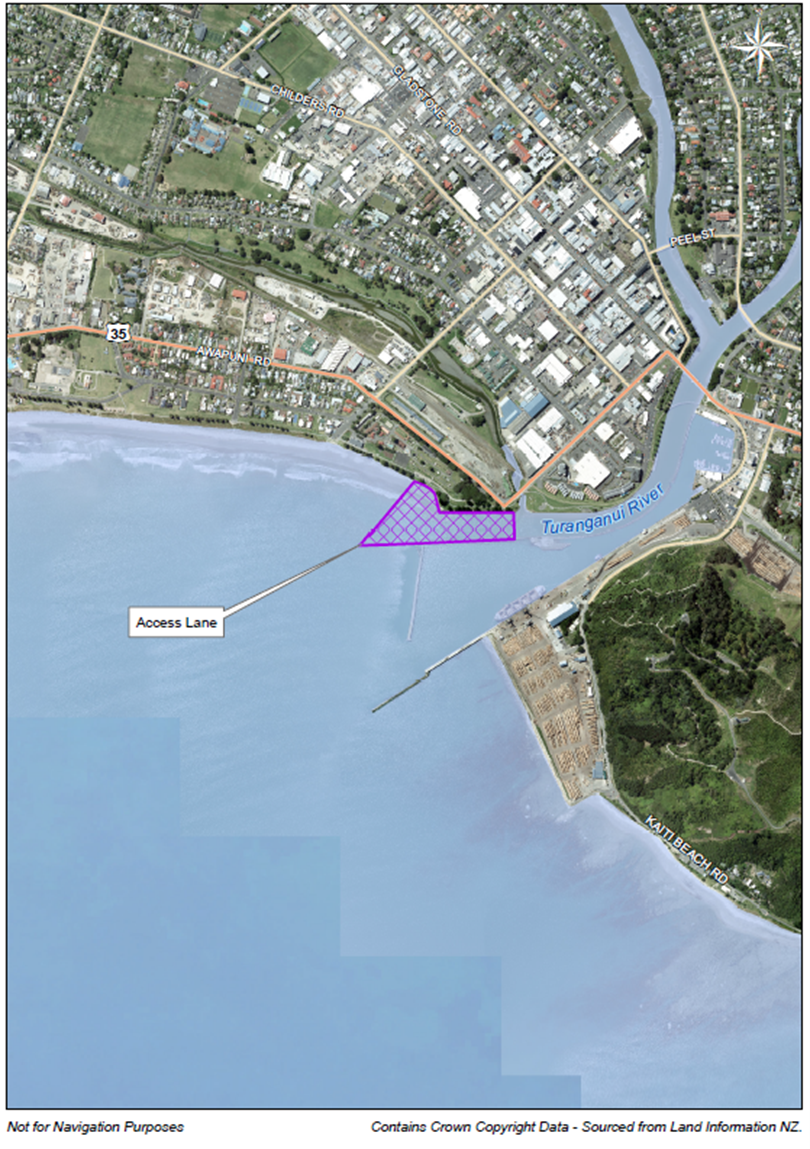
2. Kaiti Beach channel access lane
The Kaiti Beach Channel, as shown on the map below, has been reserved for the purpose of providing access for vessels navigating between the shore and the open sea. This excludes other activities from the channel, including swimmers when vessels are navigating through the channel.
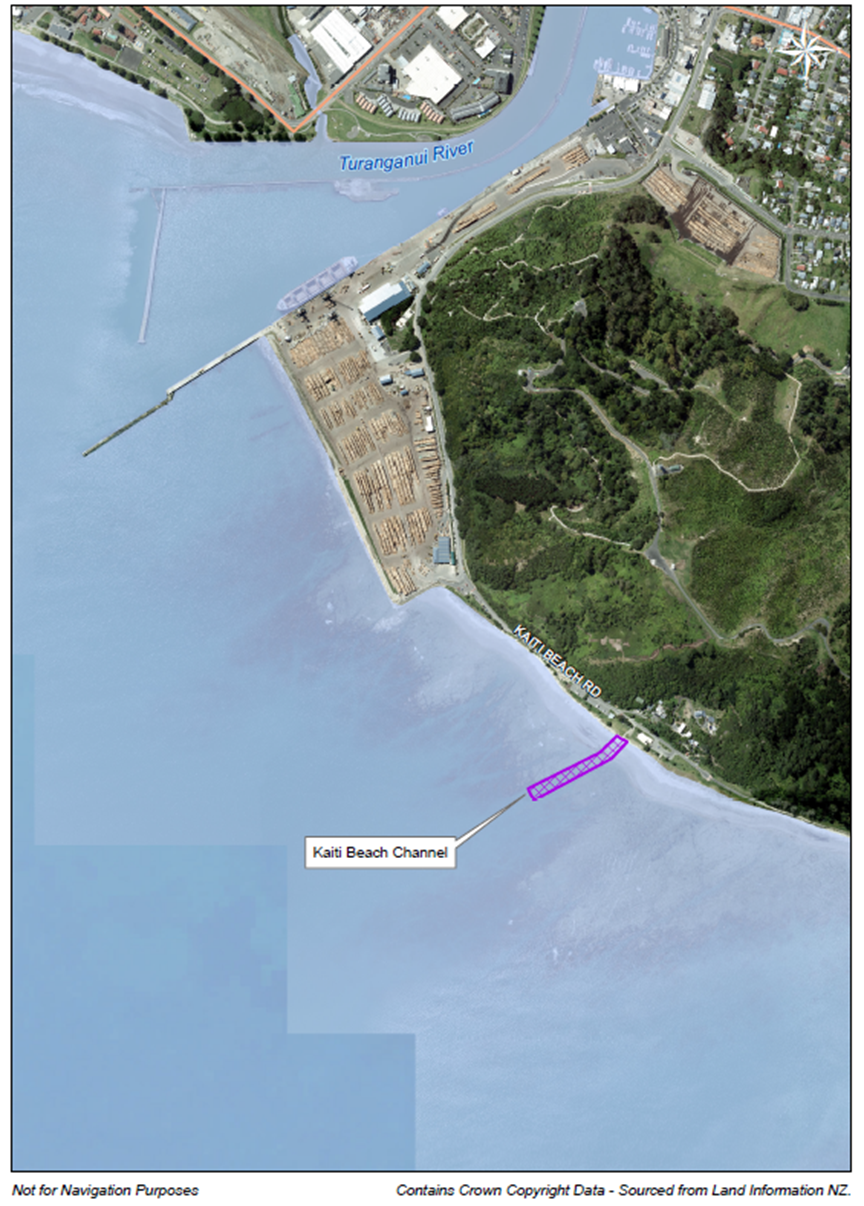
3. Personal water craft - jet ski
A specific area has been reserved for the purpose of the operation of personal water craft, located between mean High Water Springs and 200 metres offshore, extending 400 metres parallel to the short with its western end located 50 metres west of the extended centre line of Pacific Street and its eastern end located 350 metres east of the extended centre line of Pacific Street and as shown on the map below.
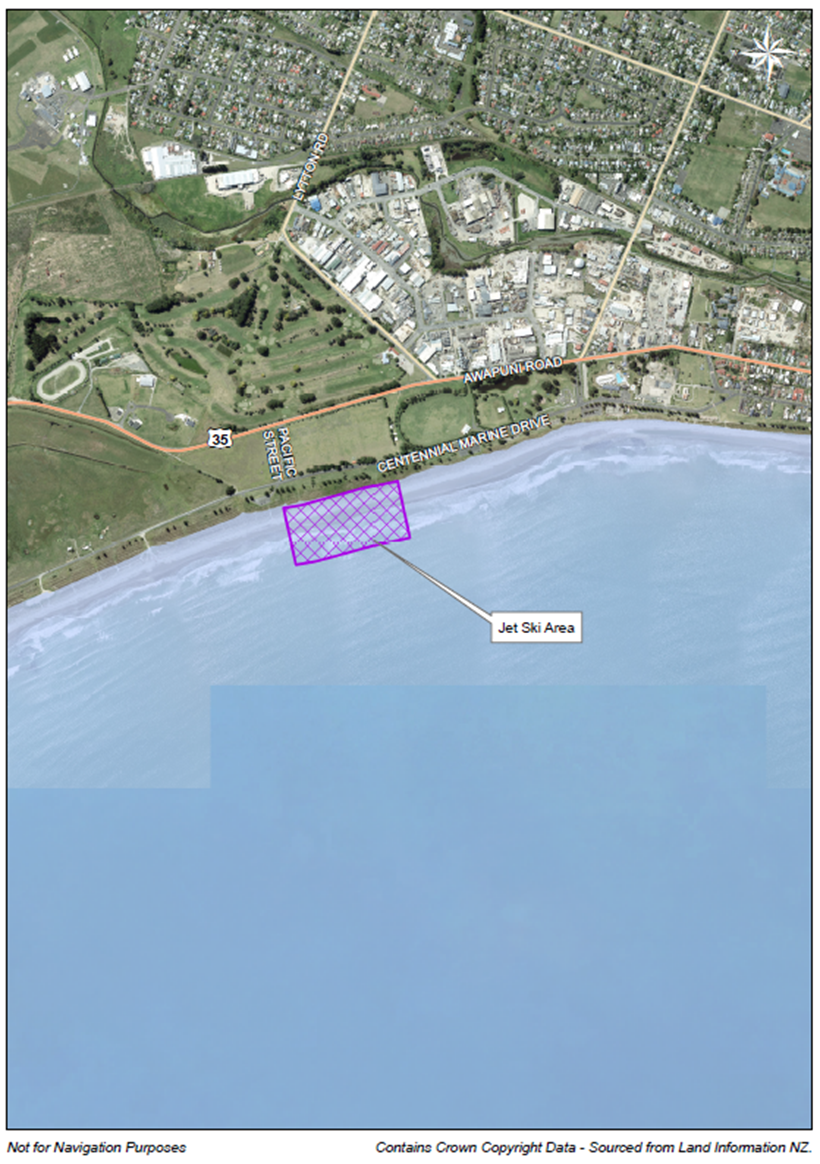
4. Tolaga Bay ski lane
An area of the Uawa River, Tolaga Bay has been reserved for water skiing purposes, as shown on the map below.
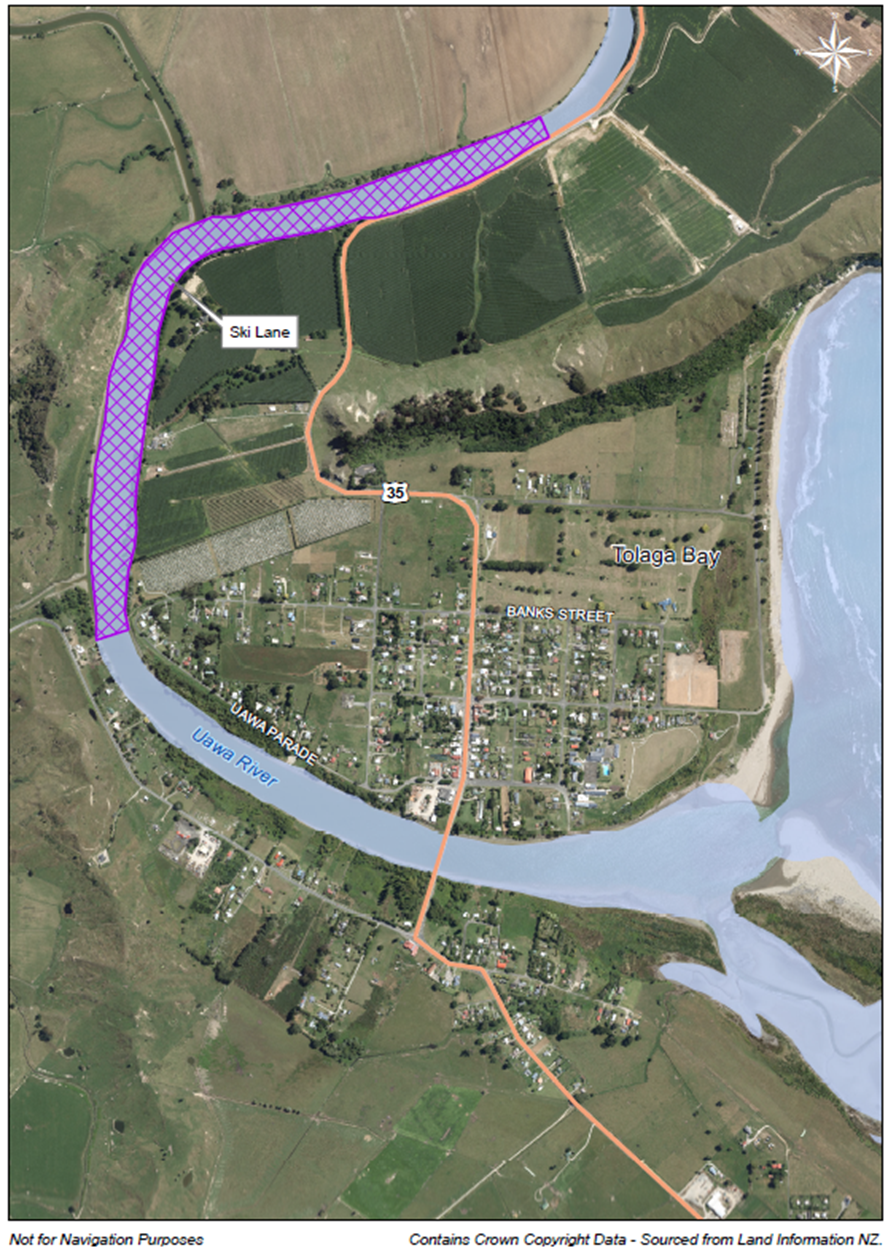
Schedule 2 - Defined Areas
1. Gisborne Harbour limits
The Gisborne Harbour Limits is the area of Tūranganui-a-Kiwa / Poverty Bay waters enclosed by a line drawn from Tuaheni Point to Young Nicks Head as shown on the map below.
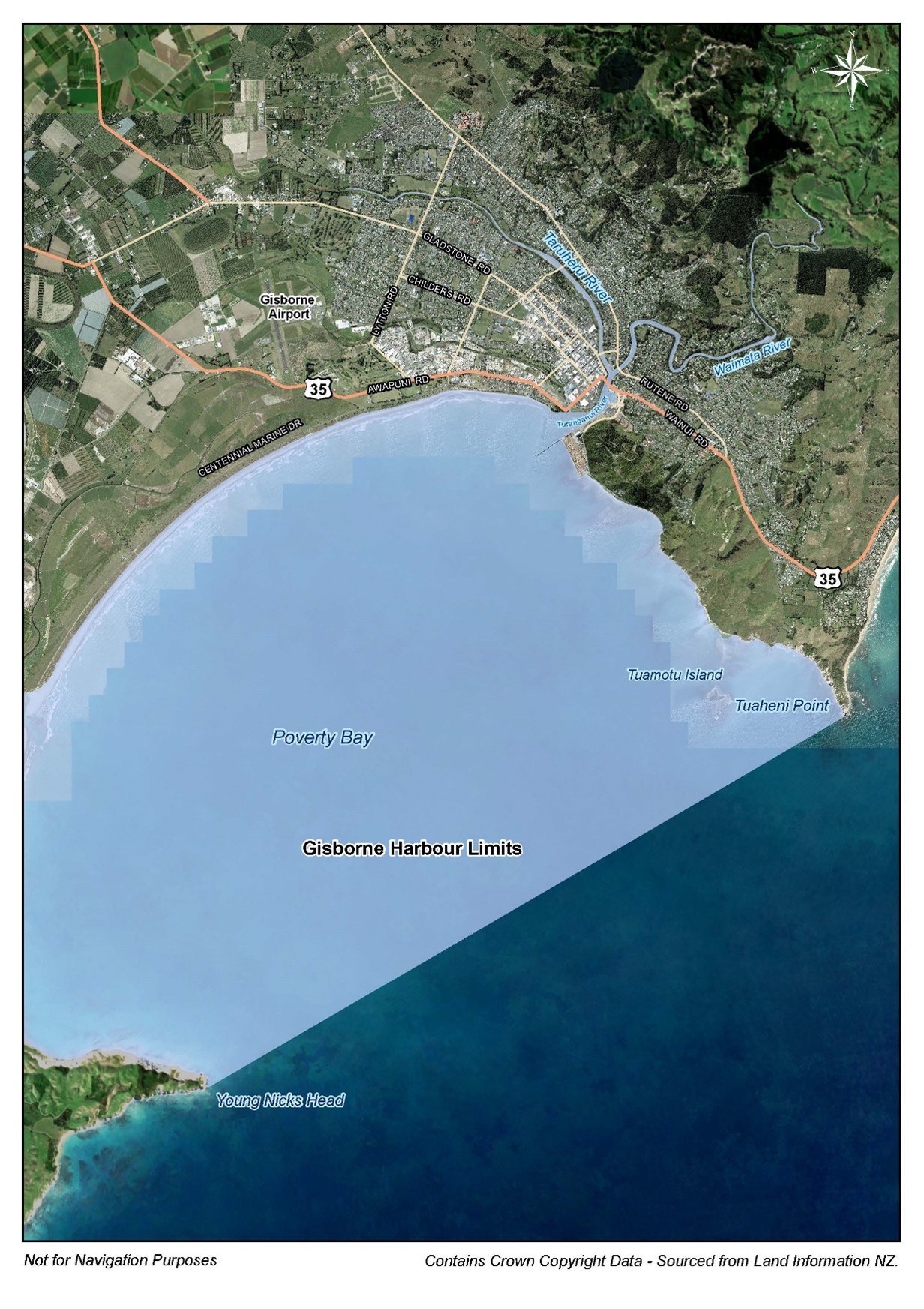
2. Entrance channel and swinging basin
(a)The entrance channel and swinging basin are shown on the map below.
- (i) Waihora rock west cardinal mark - 38 42.21 S Lat 178 01.65 E Long
- (ii) Far Port hand channel entrance buoy – 38 41.008 S Lat 178 00.300 E Long
- (iii) Port hand mid channel marker – 38 40.822 S Lat 178 00.687 E Long
- (iv) Starboard mid channel marker – 38 40.901 S Lat 178 00.761E Long
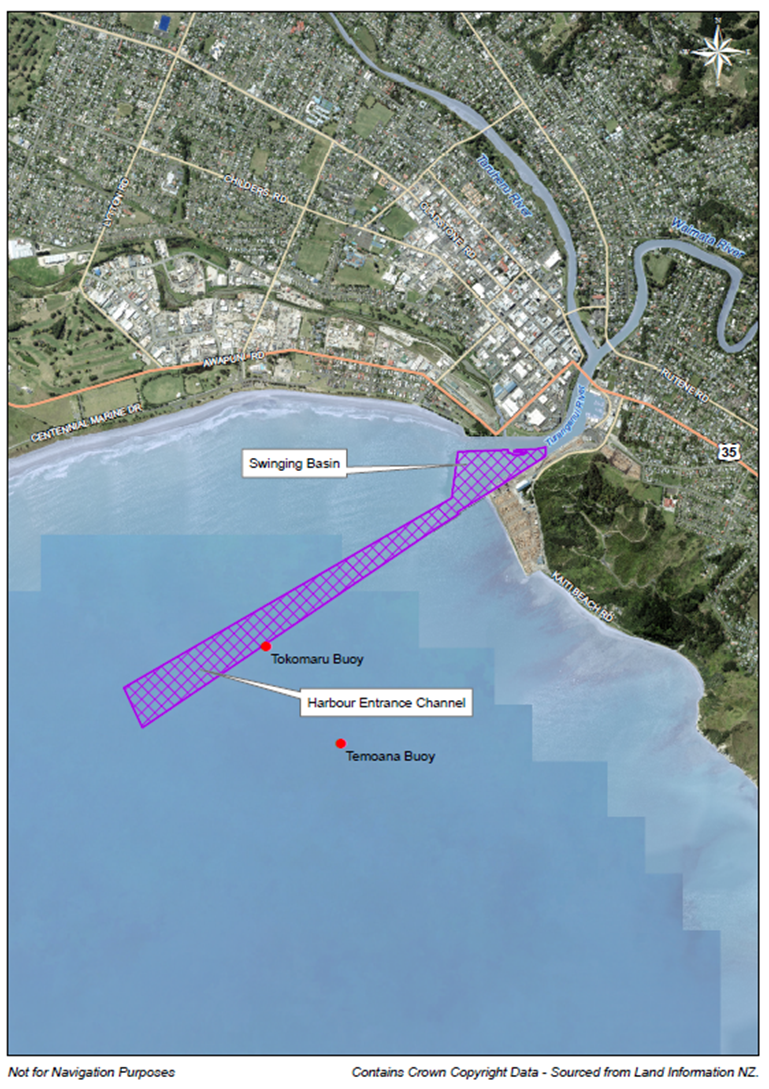
3. Large vessel anchoring position
(a) Anchoring of large vessels (over 500 gross registered tonnage) is limited to three permanent anchorage positions, as shown on the map below. The designated permanent anchoring areas are located in the following positions:
(i) Anchorage 1 – Lat. 38° 43.25’S Long. 177° 58.6’E.
(ii) Anchorage 2 – Lat. 38° 43.50’S Long. 177° 59.3’E
(iii) Anchorage 3 – Lat. 38° 43.75’S Long. 178° 00.0’E.
(b) Cruise ships are permitted at the following anchorage positions as shown on the map below:
(i) Anchorage 1 – Lat. 38˚41.35’S Long 177˚59.88’E
(ii) Anchorage 2 – Lat. 38˚41.76’S Long 178˚00.18’E
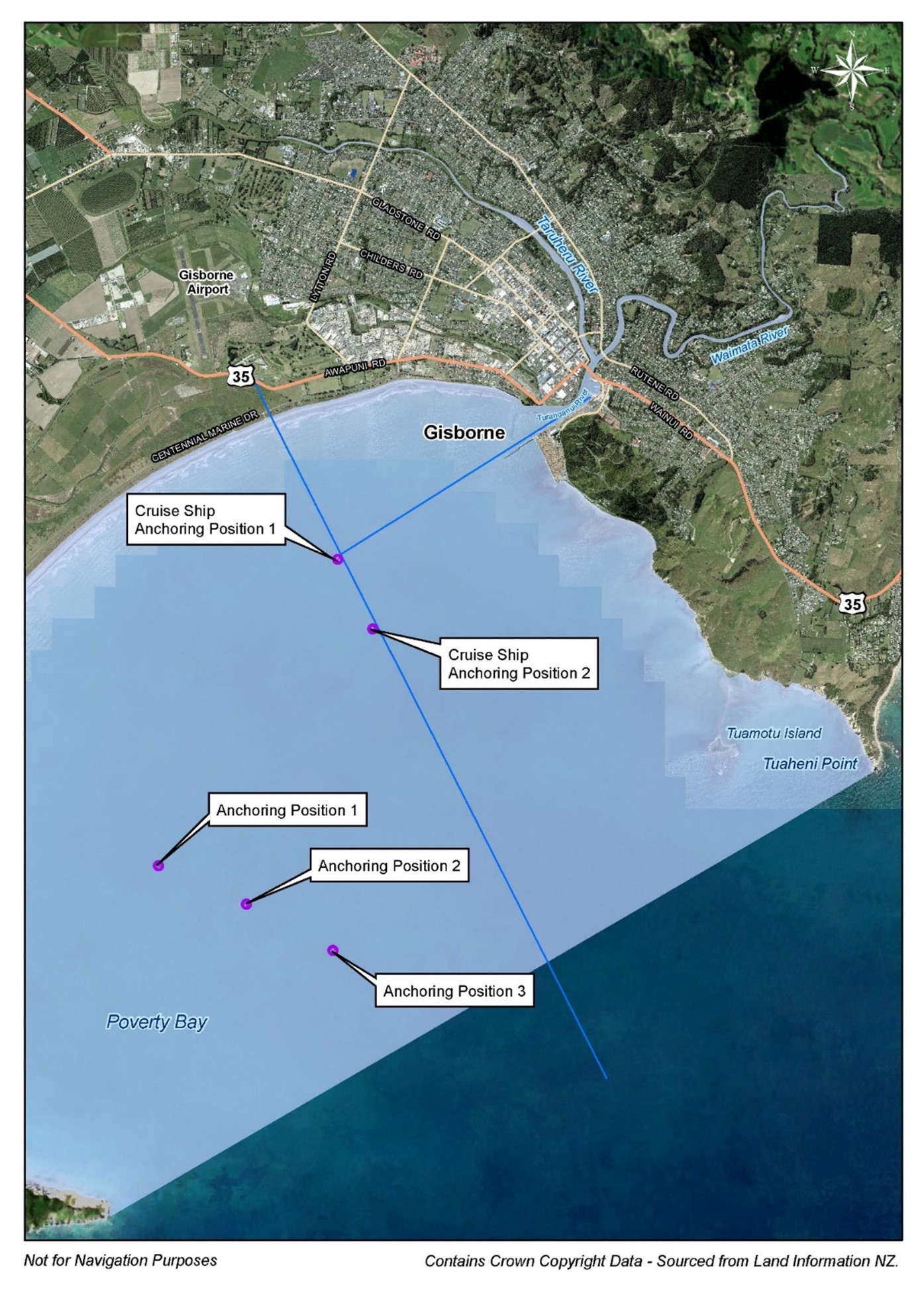
4. Prohibited anchorage areas
(1) All prohibited anchorage areas are those that are defined by New Zealand Hydrographic charts NZ 55 and NZ 5571and as shown on the map below. The co-ordinate positions (WGS 1984) are:
(a) the wastewater outfall from 38° 40.4’ S 178° 00.2’ E, hence south for a distance of 1NM;
(b) the wastewater outfall from 38° 41.1’ S 178° 02.3’ E, hence in a direction of 226°(T) for a distance of 0.65NM;
(c) the area encompassed within a circle with a radius of 1.5NM centred on a position of 38° 40.5’ S 177° 59.25’ E (Front Lead);
(d) Waihora Rock Buoy in position 38 42.21 S Lat 178 01.65 E Long
(e) Shoreward of Ariel Bank, within an area bounded by coordinate positions (WGS 1984):
- (i) Tuaheni Point Lat. 38° 42.50’ S Long. 178° 04.16’ E
- (ii) Ariel Rock Lat. 38° 43.76’ S Long. 178° 17.81’ E
- (iii) Penguin Rock Lat. 38° 39.96’ S Long. 178° 21.08’ E
- (iv) Gable End Foreland Lat. 38° 31.76’ S Long. 178° 17.53’ E
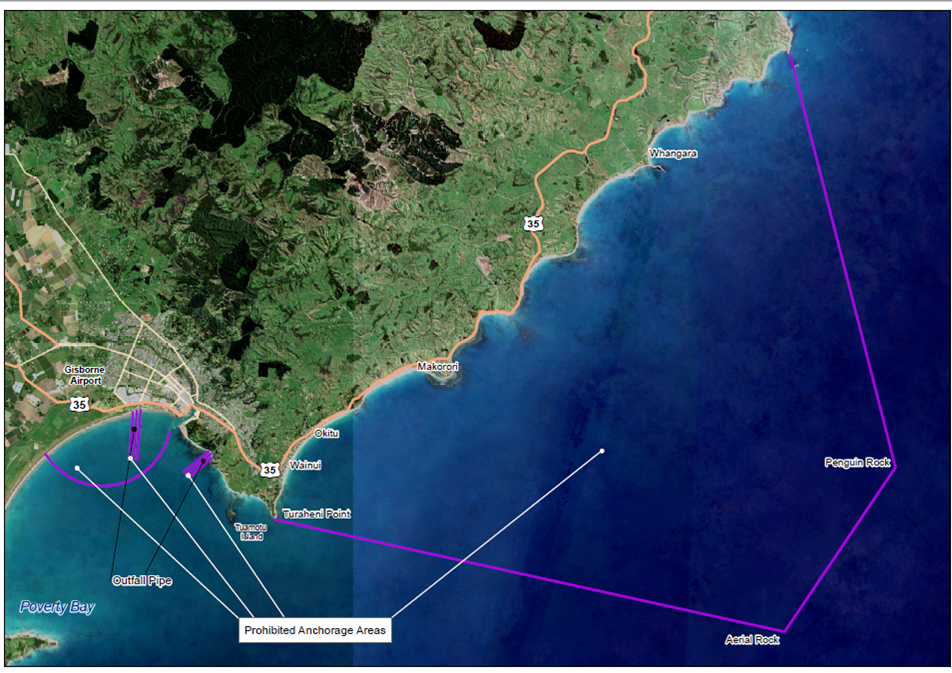
5. Gisborne pilotage area
The Gisborne Pilotage Area is defined as the area bounded seaward by the arc of a circle, radius 3 nautical miles, centred on the southern end of Butlers Wall (38° 40’.6S, 178° 01’.2E) and as shown on the map below.
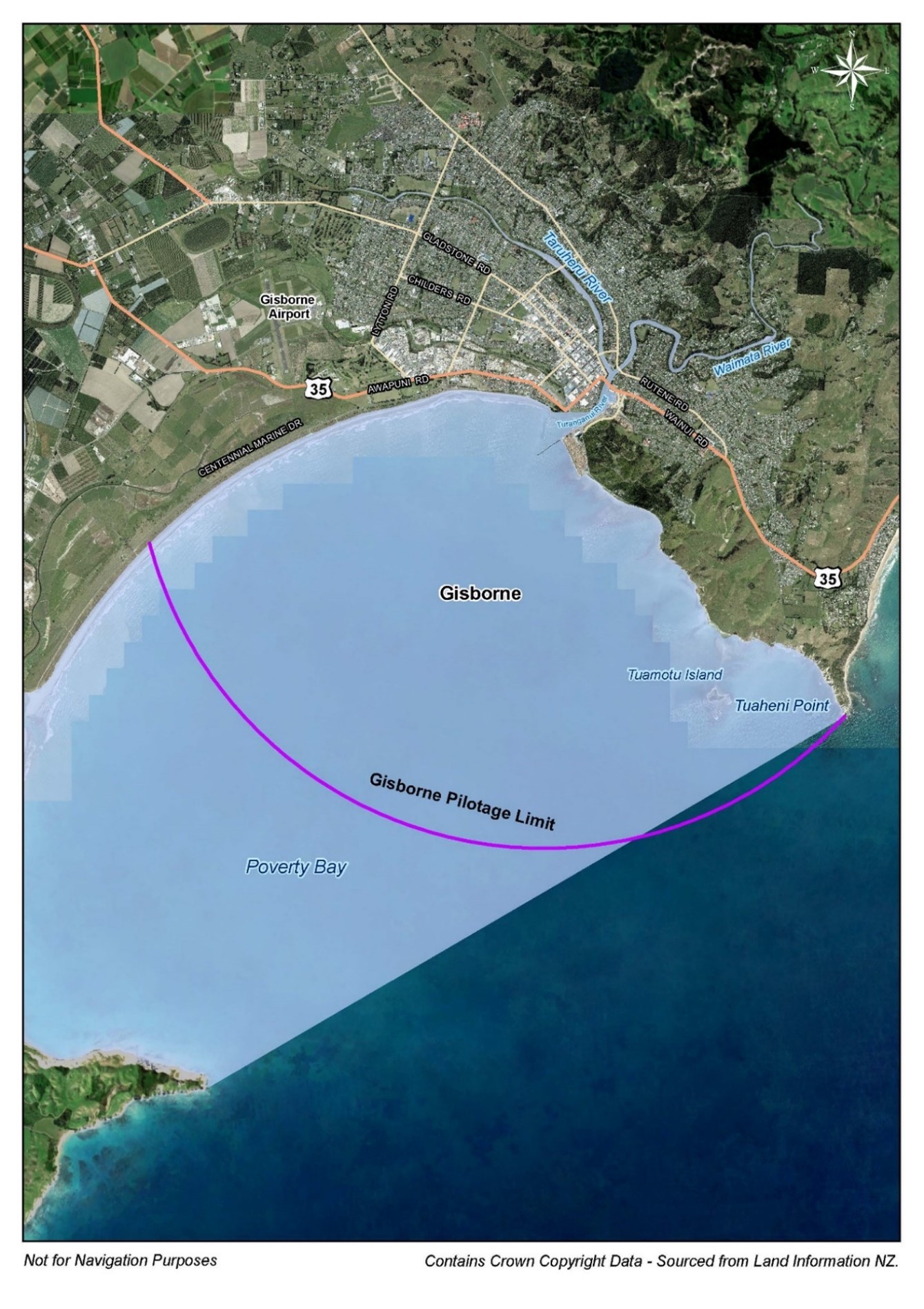
Aircraft approach area
(1) An aircraft approach area is located in the Gisborne Harbour, within co-ordinates (WGS 1984) as shown on the map below:
(a) 38° 4.7’ S 177° 58.7’ E;
(b) 38° 40.9’ S 177° 58.8’ E;
(c) 38° 40.8’ S 177° 59.2’ E;
(d) 38° 40.6’ S 177° 59.1’ E.
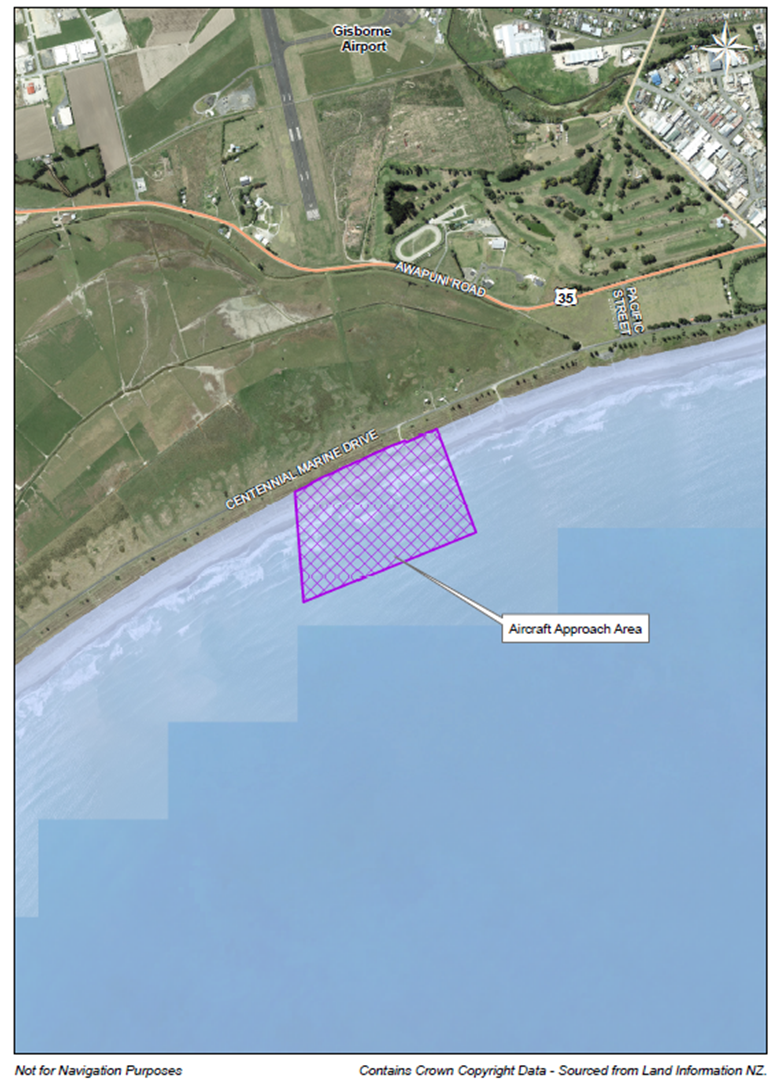
7. Crayfish pot and set-net exclusion areas
(1) Gisborne Harbour Limits
A crayfish pot and set-net exclusion area is located in the Gisborne Harbour Limits bounded by co-ordinate positions (WGS 1984) as shown on the map below:
(a)38° 40.5’ S 177° 59.1’ E Beach (MHWS), 200m w of lead line;
(b)30° 43.9’ S 178° 1.4’ E Gisborne Harbour limits, 200m of lead line;
(c)30° 42.5’ S 178° 4.1’ E Tuahine Point;
(d)38° 42.4‘’S 178° 2.8’ E Tuamotu Island;
(e)38° 42.2’ S 178° 1.6’ E Waihora Buoy
(f)38 ° 40.7’ S 178° 1.1’ E Breakwater
and seaward of:
(g)A right line drawn across the Waikanae Creek along the extended centreline of Lowe Street;
(h)A right line drawn across the Taruheru River along the line of the seaward side of the Peel Street Bridge;
(i)A right line drawn across the Waimata River above stream at the landmark commonly referred to as the Island.
(j)Waihora Rock Buoy in position 38 42.21 S Lat 178 01.65 E Long.
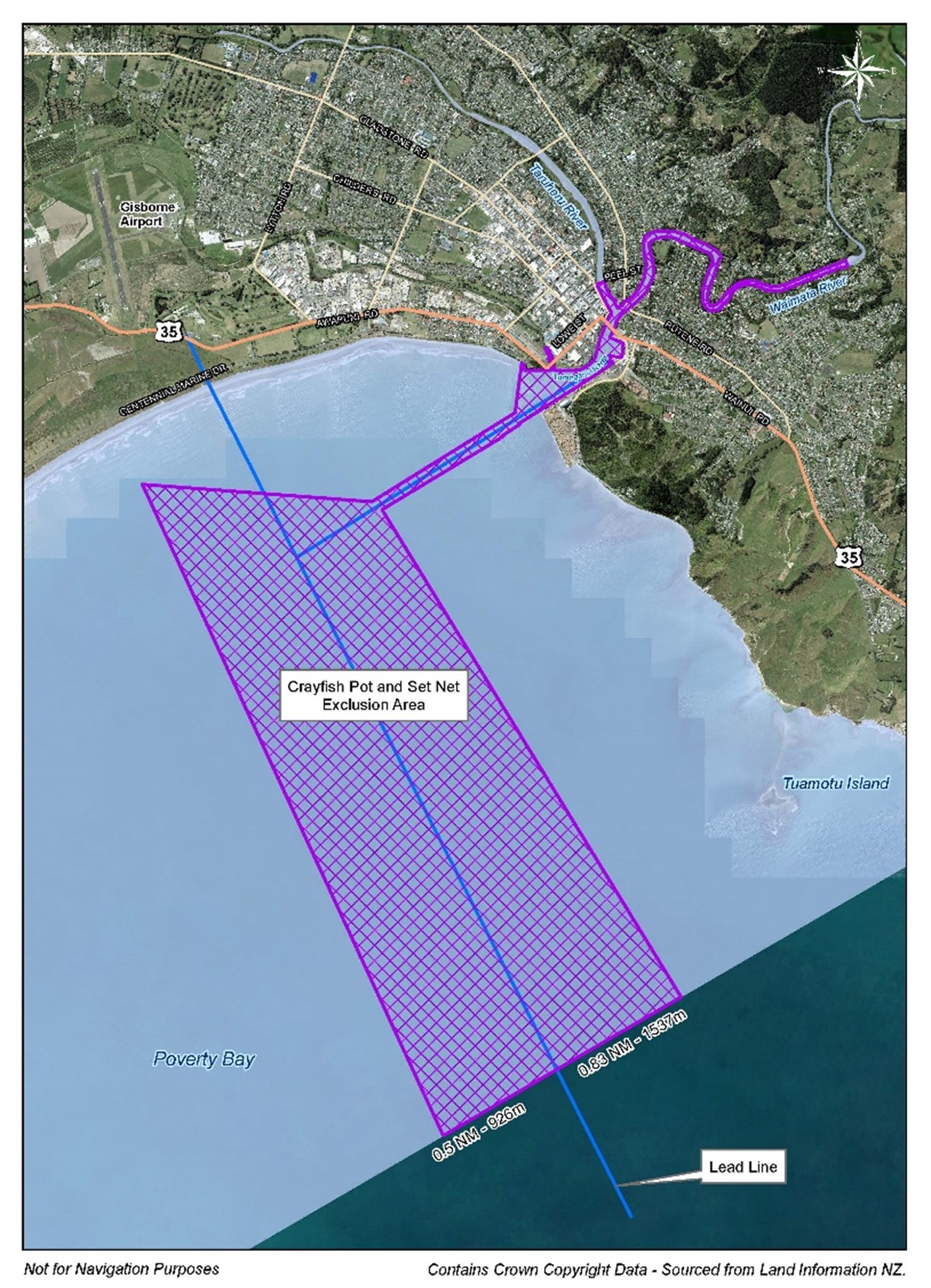
(2) Tatapouri
A crayfish pot and set-net exclusion area is located in the Tatapouri Channel Area bounded by co-ordinate positions (WGS 1984) as shown on the map below:
(a)38º38.734’S 178º8.746’E
(b)38º38.752’S 178º8.742’E
(c)38º38.796’S 178º8.948’E
(d)38º38.814’S 178º8.944’E
(e)38º38.185’S 178º9.015’E
(f)38º38.815’S 178º9.0155’E
